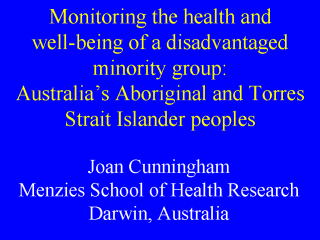|
|
|
|
front
|1
|2
|3
|4
|5
|6
|7
|8
|9
|10
|11
|12
|13
|14
|15
|16
|17
|18
|19
|20
|21
|22
|23
|24
|25
|26
|27
|28
|29
|30
|31
|32
|33
|34
|review
|
 |
This lecture is about the challenges of monitoring the health
and well-being of
Australia’s Indigenous peoples. Although the data are specific to a particular
group in a particular country, many of the issues are relevant to other
developed countries with indigenous populations, as well as to other population
sub-groups.
(Note: in this presentation, the word "indigenous" will be
spelled with an upper-case "I" when used to refer collectively to
Aboriginal and Torres Strait Islander Australians, and with a lower-case "i"
when used more generally. Joan Cunningham is currently an epidemiologist at the Menzies School of Health Research in Darwin, Northern Territory, Australia. To contact the author, please e-mail joan.cunningham@menzies.edu.au. This lecture is based on her experiences in her previous position as the first epidemiologist and director of research at the National Centre for Aboriginal and Torres Strait Islander Statistics, which was established in 1995. This Centre is part of the Australian government’s national statistical agency, the Australian Bureau of Statistics, and it also functions as a collaborating unit of the Australian Institute of Health and Welfare. For more information about the Centre, copy and paste the following address into your web browser:
|